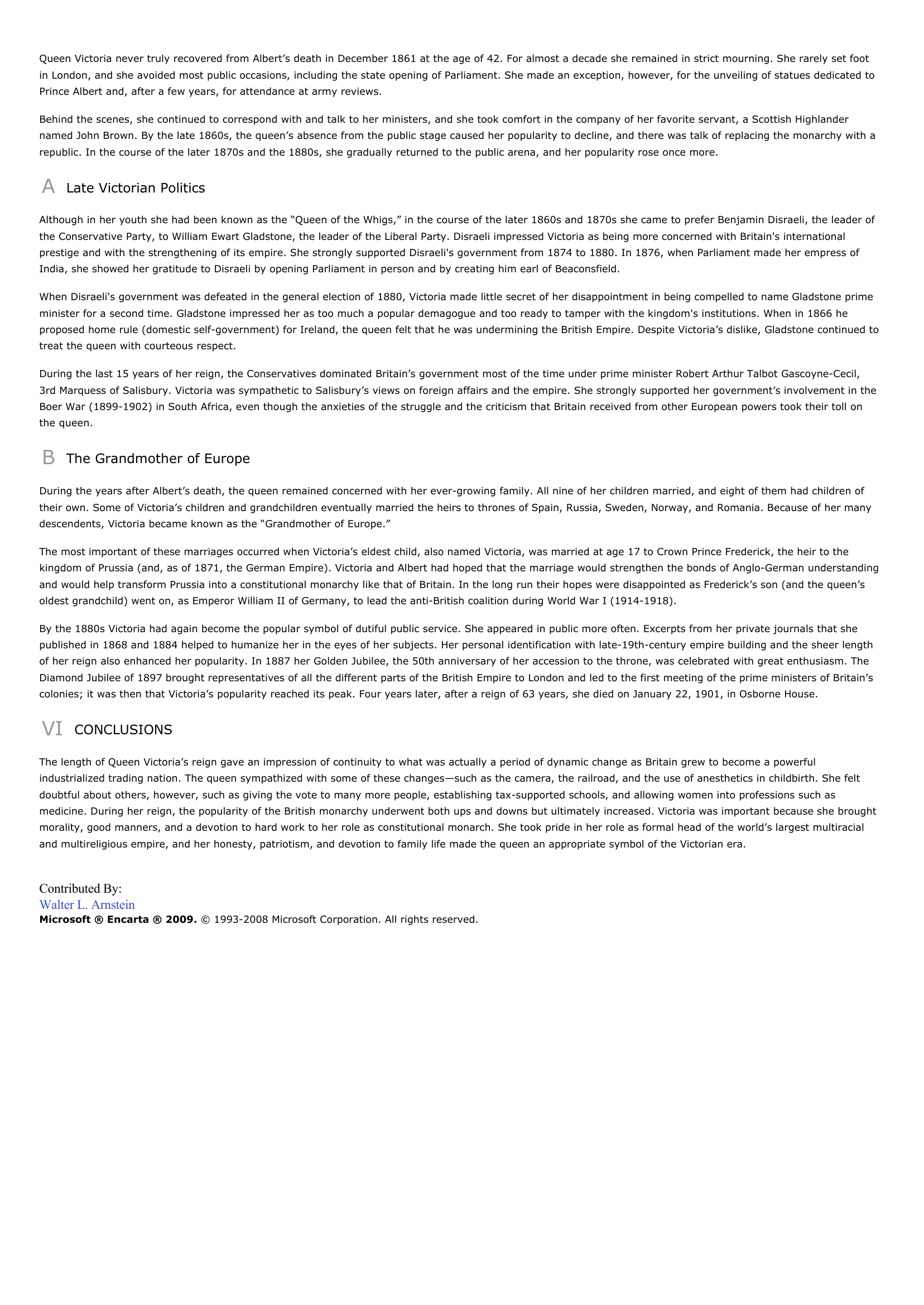Victoria (queen).
Publié le 03/05/2013

Extrait du document
«
Queen Victoria never truly recovered from Albert’s death in December 1861 at the age of 42.
For almost a decade she remained in strict mourning.
She rarely set footin London, and she avoided most public occasions, including the state opening of Parliament.
She made an exception, however, for the unveiling of statues dedicated toPrince Albert and, after a few years, for attendance at army reviews.
Behind the scenes, she continued to correspond with and talk to her ministers, and she took comfort in the company of her favorite servant, a Scottish Highlandernamed John Brown.
By the late 1860s, the queen’s absence from the public stage caused her popularity to decline, and there was talk of replacing the monarchy with arepublic.
In the course of the later 1870s and the 1880s, she gradually returned to the public arena, and her popularity rose once more.
A Late Victorian Politics
Although in her youth she had been known as the “Queen of the Whigs,” in the course of the later 1860s and 1870s she came to prefer Benjamin Disraeli, the leader ofthe Conservative Party, to William Ewart Gladstone, the leader of the Liberal Party.
Disraeli impressed Victoria as being more concerned with Britain's internationalprestige and with the strengthening of its empire.
She strongly supported Disraeli's government from 1874 to 1880.
In 1876, when Parliament made her empress ofIndia, she showed her gratitude to Disraeli by opening Parliament in person and by creating him earl of Beaconsfield.
When Disraeli's government was defeated in the general election of 1880, Victoria made little secret of her disappointment in being compelled to name Gladstone primeminister for a second time.
Gladstone impressed her as too much a popular demagogue and too ready to tamper with the kingdom's institutions.
When in 1866 heproposed home rule (domestic self-government) for Ireland, the queen felt that he was undermining the British Empire.
Despite Victoria’s dislike, Gladstone continued totreat the queen with courteous respect.
During the last 15 years of her reign, the Conservatives dominated Britain’s government most of the time under prime minister Robert Arthur Talbot Gascoyne-Cecil,3rd Marquess of Salisbury.
Victoria was sympathetic to Salisbury’s views on foreign affairs and the empire.
She strongly supported her government’s involvement in theBoer War (1899-1902) in South Africa, even though the anxieties of the struggle and the criticism that Britain received from other European powers took their toll onthe queen.
B The Grandmother of Europe
During the years after Albert’s death, the queen remained concerned with her ever-growing family.
All nine of her children married, and eight of them had children oftheir own.
Some of Victoria’s children and grandchildren eventually married the heirs to thrones of Spain, Russia, Sweden, Norway, and Romania.
Because of her manydescendents, Victoria became known as the “Grandmother of Europe.”
The most important of these marriages occurred when Victoria’s eldest child, also named Victoria, was married at age 17 to Crown Prince Frederick, the heir to thekingdom of Prussia (and, as of 1871, the German Empire).
Victoria and Albert had hoped that the marriage would strengthen the bonds of Anglo-German understandingand would help transform Prussia into a constitutional monarchy like that of Britain.
In the long run their hopes were disappointed as Frederick’s son (and the queen’soldest grandchild) went on, as Emperor William II of Germany, to lead the anti-British coalition during World War I (1914-1918).
By the 1880s Victoria had again become the popular symbol of dutiful public service.
She appeared in public more often.
Excerpts from her private journals that shepublished in 1868 and 1884 helped to humanize her in the eyes of her subjects.
Her personal identification with late-19th-century empire building and the sheer lengthof her reign also enhanced her popularity.
In 1887 her Golden Jubilee, the 50th anniversary of her accession to the throne, was celebrated with great enthusiasm.
TheDiamond Jubilee of 1897 brought representatives of all the different parts of the British Empire to London and led to the first meeting of the prime ministers of Britain’scolonies; it was then that Victoria’s popularity reached its peak.
Four years later, after a reign of 63 years, she died on January 22, 1901, in Osborne House.
VI CONCLUSIONS
The length of Queen Victoria’s reign gave an impression of continuity to what was actually a period of dynamic change as Britain grew to become a powerfulindustrialized trading nation.
The queen sympathized with some of these changes—such as the camera, the railroad, and the use of anesthetics in childbirth.
She feltdoubtful about others, however, such as giving the vote to many more people, establishing tax-supported schools, and allowing women into professions such asmedicine.
During her reign, the popularity of the British monarchy underwent both ups and downs but ultimately increased.
Victoria was important because she broughtmorality, good manners, and a devotion to hard work to her role as constitutional monarch.
She took pride in her role as formal head of the world’s largest multiracialand multireligious empire, and her honesty, patriotism, and devotion to family life made the queen an appropriate symbol of the Victorian era.
Contributed By:Walter L.
ArnsteinMicrosoft ® Encarta ® 2009. © 1993-2008 Microsoft Corporation.
All rights reserved..
»
↓↓↓ APERÇU DU DOCUMENT ↓↓↓
Liens utiles
- REINE VICTORIA (La) [Queen Victoria] de Giles Lytton Strachey
- Biographie Queen Victoria
- Queen Victoria - biography.
- Victoria (queen) I INTRODUCTION Victoria (queen) (1819-1901), queen of the United Kingdom of Great Britain and Ireland (1837-1901) and empress of India (1876-1901).
- Queen Victoria










